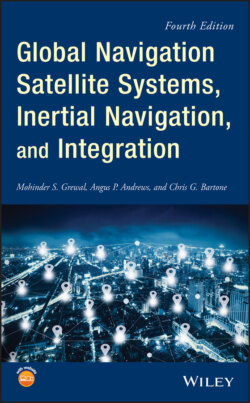Читать книгу Global Navigation Satellite Systems, Inertial Navigation, and Integration - Mohinder S. Grewal - Страница 60
2.3.2.1 Symmetric Solution Using Two Transmitters on Land
ОглавлениеIn this case, the receiver and two transmitters are located in the same plane, as shown in Figure 2.3, with known positions of the two transmitters: x1, y1 and x2, y2. Ranges R1 and R2 from the two transmitters to the user position are calculated as
(2.1)
(2.2)
where
| c | = | speed of light (0.299 792 458 m/ns) |
| ΔT1 | = | time taken for the radiowave to travel from transmitter 1 to the user (ns) |
| ΔT2 | = | time taken for the radiowave to travel from transmitter 2 to the user (ns) |
| X, Y | = | unknown user position to be solved for (m) |
The range to each transmitter can be written as
(2.3)
Figure 2.3 Two transmitters with known 2D positions.
(2.4)
Expanding R1 and R2 in Taylor series expansion with small perturbation in X by Δx and Y by Δy yields
(2.5)
(2.6)
where u1 and u2 are higher‐order terms. The derivatives of Eqs. (2.3) and (2.4) with respect to X, Y are substituted into Eqs. (2.5) and (2.6), respectively.
Thus, for the symmetric case, we obtain
(2.7)
(2.8)
To obtain the least‐squares estimate of (X, Y), we need to minimize the quantity
(2.9)
which is
(2.10)
The solution for the minimum can be found by setting ∂J/∂Δx = 0 = ∂J/∂Δy, then solving for Δx and Δy:
(2.11)
(2.12)
with solution
(2.13)
The solution for Δy may be found in similar fashion as
(2.14)
